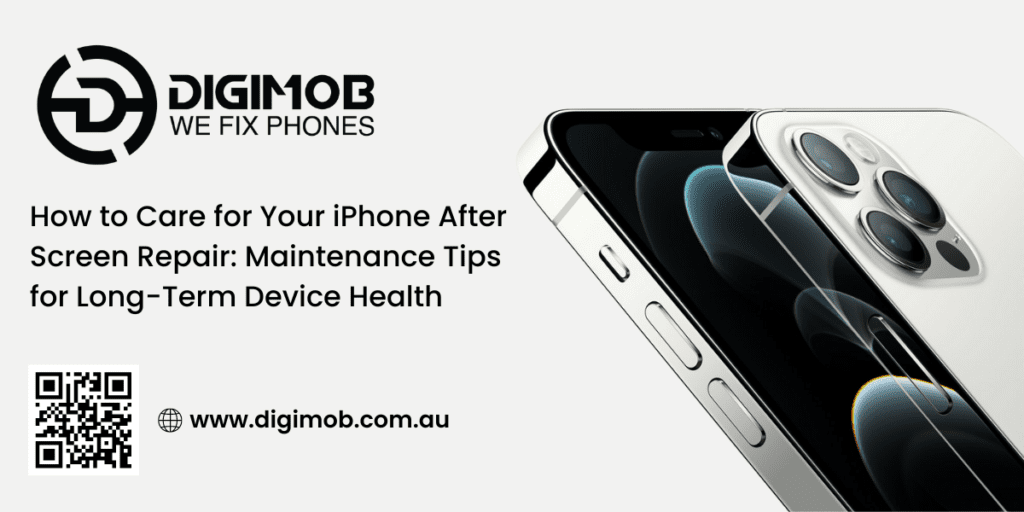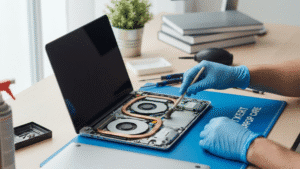After investing in a screen repair for your iPhone, it’s crucial to take steps to ensure the longevity and performance of your device. Proper care and maintenance can help prevent further damage and keep your iPhone functioning smoothly. Here are some essential tips to care for your iPhone after a screen repair.

1. Use a High-Quality Screen Protector
One of the simplest yet most effective ways to protect your newly repaired screen is by applying a high-quality screen protector. Choose a tempered glass protector for robust protection against drops and impacts. A screen protector will help prevent scratches and cracks, extending the life of your repaired screen.
2. Invest in a Durable Case
A durable, shock-absorbent case provides an additional layer of protection for your iPhone. Look for cases with reinforced corners and raised edges to protect your screen from direct impacts. Cases made from materials like silicone, rubber, or hybrid plastics are ideal for absorbing shocks and preventing damage from drops.
3. Avoid Extreme Temperatures
Exposing your iPhone to extreme temperatures can cause damage to the internal components and the screen. Avoid leaving your device in hot cars, direct sunlight, or near heat sources. Similarly, protect it from freezing temperatures by keeping it in a pocket or bag when you’re outside in cold weather.
4. Keep Your Device Clean
Regularly clean your iPhone to maintain its appearance and functionality. Use a soft, lint-free cloth to wipe down the screen and body. Avoid using harsh chemicals or abrasive materials that could damage the screen or the oleophobic coating. A screen cleaning solution designed for electronic devices can help remove smudges and fingerprints effectively.
5. Handle with Care
While it’s tempting to use your iPhone one-handed or while multitasking, handling it with care can prevent accidents. Avoid holding your device over hard surfaces and use both hands when possible. Being mindful of how you handle your iPhone can reduce the risk of drops and impacts.
6. Keep Away from Water and Moisture
Even if your iPhone is water-resistant, prolonged exposure to water and moisture can cause damage. Avoid using your device in humid environments like bathrooms or near pools. If your iPhone gets wet, dry it thoroughly with a soft cloth and allow it to air dry before using it again.
7. Regularly Update Your Software
Keeping your iPhone’s software up to date ensures you have the latest security patches and performance improvements. Regular updates can also fix bugs that might affect your device’s operation. Go to Settings > General > Software Update to check for and install updates.
8. Monitor Battery Health
Battery health impacts overall device performance. Avoid letting your battery drain completely or overcharging it. Try to keep your battery level between 20% and 80%. You can check your battery health by going to Settings > Battery > Battery Health. If your battery health is significantly degraded, consider having it replaced.
9. Backup Your Data
Regularly backing up your iPhone ensures that your data is safe in case of any future issues. Use iCloud or connect your device to a computer to create backups. This practice not only protects your data but also makes it easier to restore your device if needed.
10. Be Mindful of App Usage
Some apps can strain your iPhone’s processor and battery, leading to overheating and potential damage. Monitor your app usage and close apps running in the background that you aren’t using. Go to Settings > Battery to see which apps are consuming the most power and adjust your usage accordingly.
11. Use a Padded Storage Solution
When not in use, store your iPhone in a padded pouch or compartment within your bag. This additional cushioning protects your device from bumps and drops when you’re on the move. Look for a storage solution with a soft lining to prevent scratches and enough padding to absorb shocks.
12. Avoid Overloading the Device
Running too many apps simultaneously or using graphic-intensive applications can overload your iPhone, causing it to overheat and strain its components. Regularly close unused apps and avoid running multiple heavy apps at once. This practice helps maintain your device’s performance and prevents unnecessary wear and tear.
13. Schedule Regular Checkups
If you use your iPhone heavily or it has sustained multiple repairs, consider scheduling regular checkups with a professional repair service. A technician can inspect your device for any potential issues, such as battery health, screen integrity, and internal component functionality. Regular checkups can catch problems early and extend the lifespan of your iPhone.
14. Enable Auto-Lock and Reduce Screen Brightness
Enabling the auto-lock feature and reducing screen brightness can prevent screen burn-in and reduce battery consumption. Set auto-lock to a shorter duration, such as one or two minutes, to minimise screen-on time when not in use. Lowering the screen brightness not only extends battery life but also reduces strain on the screen and internal components.
15. Educate Yourself on iPhone Maintenance
Stay informed about best practices for iPhone care by reading articles, watching tutorials, and keeping up with updates from Apple. Understanding how to properly maintain your device will help you implement effective care routines and troubleshoot minor issues before they escalate.
By implementing these additional tips, you can further ensure the longevity and optimal performance of your iPhone after a screen repair. Regular maintenance, careful handling, and staying informed about best practices will keep your device in top condition, providing you with a reliable and durable companion for years to come.
Do you have gadget glitches? No worries! ????️ From laptops ????️ to iPhones ????, MacBooks ???? to iPads, and even Samsung, Android phones, and all other major brands, we’ve got you covered! ???? Our team offers swift and reliable repairs for all your digital needs. ???? Visit digimob.com.au today!
By following these maintenance tips, you can keep your iPhone in excellent condition long after a screen repair. Proper care and attention will help extend the life of your device, ensuring it remains functional and reliable for years to come.


